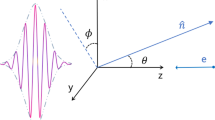Abstract
Based on Thomson scattering classical theory and single-electron model, we study the spatial spectrum and spectrum of laser driven high-energy electron radiation corresponding to different waist radius and initial phase. With the help of MATLAB software to complete the numerical simulation, we find that with the initial phase is unchanged, when the beam waist radius \({b}_{0}\) increases, the trajectory of the electron does not change significantly. The main peak of the three-dimensional spectrum will rise slightly near \({b}_{0}=2.2{\lambda }_{0}\), and then decline sharply, and the corresponding harmonic number is also declining. While the secondary peak keeps rising, and its corresponding harmonic frequency also keeps rising. When the initial phase value is larger, the sharp drop of the main peak and the sharp rise of the secondary peak in the spectrum will be more obvious, and the secondary peak is more sensitive to the change of polar angle. In the spatial spectrum, the angle range will increase with the increase in \({b}_{0}\), and the collimation will become worse. In addition, when the beam waist radius is unchanged and the electron collides at the focus, the monochromaticity of the scattering spectrum and the highest harmonic number of energy are not affected by the initial phase, and the change of the initial phase makes the maximum single harmonic energy of the scattered light change periodically, with its period of \(\pi\), and the curve is approximate to a trigonometric function curve. When the initial phase increases, it can be seen from the top of the spatial spectrum that the maximum radiation direction rotates counterclockwise. When the pulse width increases, the monochromaticity of the spectrum becomes worse, the width becomes narrower, and a redshift phenomenon occurs. These results will be helpful to understand the nonlinear Thomson scattering.










Similar content being viewed by others
References
P Maine, D Strickland, P Bado et al IEEE Journal of Quantum electronics 24 398 (1988)
M Perry and G Mourou Terawatt to Petawatt Subpicosecond Lasers 264 917 (1994)
T Eidam, S Hanf, E Seise et al Optics Letters 35 94 (2010)
G Mourou, C Barty and M Perry Physics Today 51 22 (1998)
P Corkum, F Krausz Attosecond Science 3 381 (2007)
F Krausz and M Ivanov Attosecond physics 81 163 (2009)
I Sakai, T Aoki, K Dobashi et al Physical Review Special Topics-Accelerators and Beams 6 091001 (2003)
W Yan, C Fruhling, G Golovin et al High-order multiphoton thomson scattering 11 514 (2017)
K Khrennikov, J Wenz, A Buck et al Physical Review Letters 114 195003 (2015)
J Zhuang, Y Yan, X Zhou et al Laser Physics 31 035401 (2021)
Y Mikhailova, V Platonenko and S Rykovanov Journal of Experimental and Theoreti-cal Physics Letters 81 571 (2005)
K Phuoc, S Corde, C Thaury et al Nature Photonics 6 308 (2012)
P Suortti and W Thomlinson Physics in Medicine & Biology 48 R1 (2003)
Z Chi, Y Du, W Huang et al Journal of Synchrotron Radiation 27 737 (2020)
K Lee, S Chung, S Park et al Europhysics Letters 89 64006 (2010)
A Baltuška, T Udem, M Uiberacker et al Nature 421 611 (2003)
H R Wang, F Y Xia, Y W Tian. Laser Technology, (2021) https://kns.cnki.net/kcms/detail/51.1125.tn.20210608.1356.006.html
Y L Yan, X Zhou, S L Ren, et al. Laser Technology, (2021) https://kns.cnki.net/kcms/detail/51.1125.tn.20210629.1330.006.html
K Lee, Y Cha, M Shin et al Physical Review E 67 026502 (2003)
J Zheng, Z Sheng, J Zhang et al Acta Physica Sinica 54 1018 (2005)
O Vais, S Bochkarev and V Bychenkov. Plasma Physics Reports 42 818 (2016)
K Li, L Li, Q Shu et al Optik 183 813 (2019)
Y Wang, C Wang, K Li et al Laser Physics Letters 18 15303 (2018)
D Bauer and P Mulser And W Steeb. Physical Review Letters 75 4622 (1995)
Z Chen, H Qin, X Chen et al Laser Physics 31 075401 (2021)
Acknowledgements
This work has been supported by the National Natural Sciences Foundation of China under Grant No. 10947170/A05 and No. 11104291, Natural science fund for colleges and universities in Jiangsu Province under Grant No. 10KJB140006, Natural Sciences Foundation of Shanghai under Grant No. 11ZR1441300 and Natural Science Foundation of Nanjing University of Posts and Telecommunications under Grant No. NY221098 and sponsored by Jiangsu Qing Lan Project and STITP Project under Grant No. 202210293150Y.
Author information
Authors and Affiliations
Corresponding author
Additional information
Publisher's Note
Springer Nature remains neutral with regard to jurisdictional claims in published maps and institutional affiliations.
Rights and permissions
Springer Nature or its licensor (e.g. a society or other partner) holds exclusive rights to this article under a publishing agreement with the author(s) or other rightsholder(s); author self-archiving of the accepted manuscript version of this article is solely governed by the terms of such publishing agreement and applicable law.
About this article
Cite this article
Xia, L., Yuan, Y., Zhu, S. et al. Influence of beam waist radius and initial phase on spectrum and spatial spectrum. Indian J Phys 97, 4049–4058 (2023). https://doi.org/10.1007/s12648-023-02751-7
Received:
Accepted:
Published:
Issue Date:
DOI: https://doi.org/10.1007/s12648-023-02751-7




